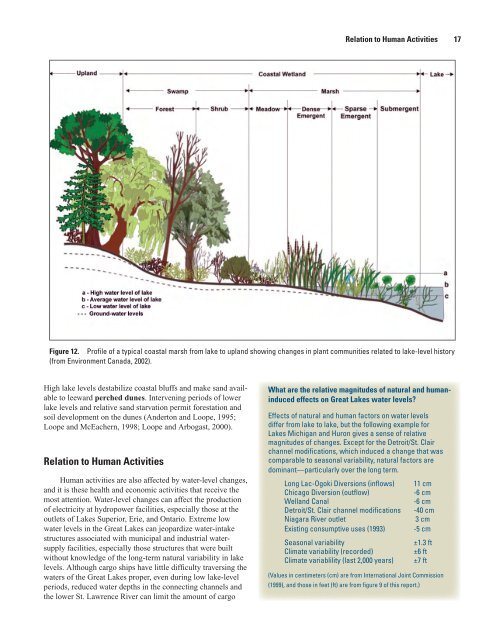Wilcox, D.A, Thompson, T.A., Booth, R.K., and Nicholas, J.R., Lake ...
Wilcox, D.A, Thompson, T.A., Booth, R.K., and Nicholas, J.R., Lake ...
Wilcox, D.A, Thompson, T.A., Booth, R.K., and Nicholas, J.R., Lake ...
You also want an ePaper? Increase the reach of your titles
YUMPU automatically turns print PDFs into web optimized ePapers that Google loves.
Relation to Human Activities 17<br />
Figure 12. Profile of a typical coastal marsh from lake to upl<strong>and</strong> showing changes in plant communities related to lake-level history<br />
(from Environment Canada, 2002).<br />
High lake levels destabilize coastal bluffs <strong>and</strong> make s<strong>and</strong> available<br />
to leeward perched dunes. Intervening periods of lower<br />
lake levels <strong>and</strong> relative s<strong>and</strong> starvation permit forestation <strong>and</strong><br />
soil development on the dunes (Anderton <strong>and</strong> Loope, 1995;<br />
Loope <strong>and</strong> McEachern, 1998; Loope <strong>and</strong> Arbogast, 2000).<br />
Relation to Human Activities<br />
Human activities are also affected by water-level changes,<br />
<strong>and</strong> it is these health <strong>and</strong> economic activities that receive the<br />
most attention. Water-level changes can affect the production<br />
of electricity at hydropower facilities, especially those at the<br />
outlets of <strong>Lake</strong>s Superior, Erie, <strong>and</strong> Ontario. Extreme low<br />
water levels in the Great <strong>Lake</strong>s can jeopardize water-intake<br />
structures associated with municipal <strong>and</strong> industrial watersupply<br />
facilities, especially those structures that were built<br />
without knowledge of the long-term natural variability in lake<br />
levels. Although cargo ships have little difficulty traversing the<br />
waters of the Great <strong>Lake</strong>s proper, even during low lake-level<br />
periods, reduced water depths in the connecting channels <strong>and</strong><br />
the lower St. Lawrence River can limit the amount of cargo<br />
What are the relative magnitudes of natural <strong>and</strong> humaninduced<br />
effects on Great <strong>Lake</strong>s water levels?<br />
Effects of natural <strong>and</strong> human factors on water levels<br />
differ from lake to lake, but the following example for<br />
<strong>Lake</strong>s Michigan <strong>and</strong> Huron gives a sense of relative<br />
magnitudes of changes. Except for the Detroit/St. Clair<br />
channel modifications, which induced a change that was<br />
comparable to seasonal variability, natural factors are<br />
dominant—particularly over the long term.<br />
Long Lac-Ogoki Diversions (inflows)<br />
Chicago Diversion (outflow)<br />
Well<strong>and</strong> Canal<br />
Detroit/St. Clair channel modifications<br />
Niagara River outlet<br />
Existing consumptive uses (1993)<br />
Seasonal variability<br />
Climate variability (recorded)<br />
Climate variablility (last 2,000 years)<br />
11 cm<br />
-6 cm<br />
-6 cm<br />
-40 cm<br />
3 cm<br />
-5 cm<br />
±1.3 ft<br />
±6 ft<br />
±7 ft<br />
(Values in centimeters (cm) are from International Joint Commission<br />
(1999), <strong>and</strong> those in feet (ft) are from figure 9 of this report.)
















